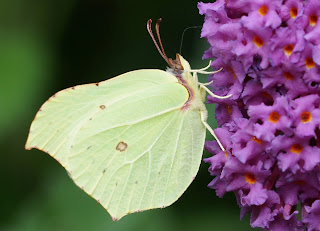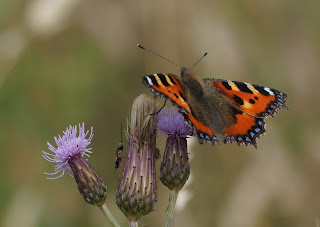I saw just the one Little Owl this morning, one of the juveniles that was sitting near the nest tree. Despite firing off three camera shots before it flew out of sight, none of my photos were in focus. But it's nice to know they're still hanging around.
Normally at this time of year the Kestrels lead their youngsters out in to the meadow to practice flying, hovering and hunting. Despite the adults being seen several times over the last few weeks, the youngsters have not yet appeared but their fledge season often depends on what kind of weather we had in spring, so there's time yet.
I encountered two thugs today at Cranford Park. The flowering kind, not the man-kind.
The first was the invasive non-native Himalayan Balsam. It is everywhere. I found it by the wood circle, in the ditches of the haha wall and sadly a massive spread of it by the river. I've copied the below from the Plantlife website.....
The largest annual plant in Britain, growing up to 2.5m high from seed in a single season. Himalayan balsam spreads quickly as it can project its seeds up to four metres. Many seeds drop into the water and contaminate land and riverbanks downstream, but the explosive nature of its seed release means it can spread upstream too. It spreads quickly and forms dense thickets, altering the ecological balance and character of wetland habitats. Many seeds drop into the water and contaminate land and riverbanks downstream, but the explosive nature of its seed release (seeds can be projected up to four meters away) means it can spread upstream too. It produces a lot of pollen over a prolonged season and is attractive to pollinating insects. There is concern that its presence may therefore result in decreased pollination for other native plants.
I also noticed that the council is aware of this as there are obvious signs that attempts are being made to remove it along the river bank. The plant needs to be destroyed before the flowers set seed.
The second thug is the buddleia. There are several of these large butterfly bushes along the wall that runs alongside the M4. They are beautiful and they do attract lots of insects, so I can tolerate them just about, but they are another invasive non-native species.
Their growth is so fast and the spread so wide, that they actually smother out any other wild flowers. If left untrimmed the stems become woody and thick and can cause damage to brickwork - there is a good example of this in the Secret Garden where the wall has very damaged brick work.
The buddleia even made the news back in July 2014 - http://www.bbc.co.uk/news/magazine-28196221
But it is good for insects and I must admit that some of the older larger buddleia bushes have already been removed, leaving just a few near the orchard, so I'm happy that the council are aware of the problem.
Two of the prettiest butterflies were found on the butterfly bushes this morning, a stunning female Brimstone.....
and this gorgeous male Red Admiral....
The Red Admiral must surely have the best marked underwing of all the butterflies....
I prefer to see butterflies on true wild flowers, like thistles, and they have flowered this week...
Female Green-veined White...
and Small Tortoiseshell....
It really was a good morning for butterflies. There was this lovely Peacock....
Several Speckled Woods.....
and lots of Commas.....
This is a close up of the underwing showing the white mark that gives this butterfly it's name...
This tiny Holly Blue was found by the river....
In the meadows there were plenty of the brown butterflies - Small Heath, Meadow Brown and Gatekeeper - and I managed to somehow not get any of them !
There are also good numbers of both Small and Large Skippers....
male Small Skipper...
female Large Skipper....
Also popping up in the meadow is the good old Ragwort. Farmers and horse owners hate ragwort as it can be poisonous to their livestock, but as Cranford Park doesn't have any horses roaming the meadows it's quite a welcome plant for insects here.
There is even a website containing all the facts you need to know about Ragwort (link here to Ragwort facts). Some nature reserves do remove Ragwort from open pastures but generally only where there are cattle and horses grazing.
Where there is Ragwort there will be Cinnabar Moth caterpillars.....
Completely harmless and they are only brightly coloured like this to deter birds from eating them.
Nearly every clump of Ragwort I found today had Cinnabar caterpillars on them.
Back in the spring of 2014 nearly every borough across the UK planted a bed of poppies in a public place, to celebrate the 100th year anniversary of World War One.
Cranford Park gave up part of the Memorial Garden (the stretch of land between the back of the St Dunstans graveyard and the River Crane) and dug up a large circle which was then planted with thousands of poppy seeds. Sadly not long after, we had dreadful storms and the rain washed the seeds to the edges of the circle, so our display wasn't that great in the end. But the area has been left untouched and is now a mini wildflower meadow, and it was lovely today to see a few poppies amongst the mix....
There were plenty of the funny looking Sicus flies enjoying the thistles....
and as the mini-meadow is so near the River Crane it was also attracting several damselflies. This one is a Common Blue...
Along the back wall behind the stable blocks I found lots of these gorgeous beetles.
They are Yellow and Black Longhorns, also known as Spotted Longhorns...
In the cherry tree I found several Forest Bugs.....
Walking down 'The Avenue' in Cranford Woods I came across two surprises......
The first was this tiny Common Toad walking across the path (toads walk, they don't hop). It was really really small so I had to get a coin out for size comparison....
and the second surprise was my find of the day.....
my first ever Lesser Stag Beetle...
We've had Stag Beetles at Cranford Park for years, and it was only a few weeks ago that I came across a huge female one, but I have never seen a Lesser Stag at Cranford Park and I wont deny it made my day.
These sightings are sure signs that the woods are looking after themselves. The beetles lay their eggs in the old log piles that are dotted around, and the larvae feed on the rotting wood.
A great five hour visit to the park, the weather was good, I bumped in to many of the regular visitors and I got a big fat patch tick.





























No comments:
Post a Comment